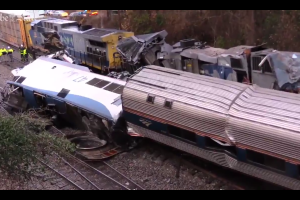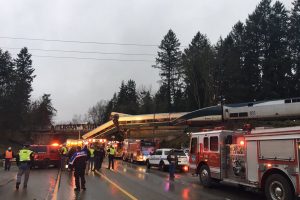NTSB Chairman Robert Sumwalt confirmed at a Monday afternoon press briefing on February 5 that the signaling system in the area of the fatal collision on Sunday that took the lives of two Amtrak employees was suspended at the time to allow maintenance workers to upgrade the system. The Amtrak train traveling from New York to Miami was diverted to an incorrect track by a track switch which was locked in place, resulting in the passenger train colliding with a CSX freight train at 50 miles per hour.
Two Amtrak employees killed when train collides with a CSX freight train
According to Sumwalt, the Event Data Recorder from the locomotive on the Amtrak train was found on Monday and sent back to an NTSB lab for processing. Data from the recorder indicate that seven seconds before impact the train engineer activated the train’s horn for three seconds; the train was traveling 56mph at the time.
Five seconds before the EDR’s recording ends, the engineer set the train’s throttle from full to idle, and then induced emergency braking three seconds before the end of the recording. The two trains eventually collided at 50mph.
The NTSB conducted interviews with the two CSX employees which were manning the CSX train, the CSX train dispatcher for the area, and the CSX trainmaster.
Operating under track warrants
At the time of collision, the CSX signaling system in the area was inoperative; track workers were working on the system performing upgrades for the eventual implementation of Positive Train Control, a system designed to help prevent train collisions and derailments.
During this signal outage, trains operate under a manual track warrant system, in which train dispatchers and engineers fill out paper forms dictating which trains are allowed to run over which sections of track. The CSX crew moving the freight train which had been backed into the track siding where the collision occurred had released their ‘authority’ back to the dispatcher, meaning that they were clear of the tracks and the dispatcher could resume moving trains through the area.
During the signal outage, the train dispatcher would not have had any other way to verify that the train crew moved the switch back into the correct position for the next train to pass.
At all times, but especially without automatic signaling, a train’s engineer would be responsible for ensuring that the switches along their route were aligned properly for their expected route of travel. Moving at 56 miles per hour, it would have taken the Amtrak train approximately seven seconds to travel 569 feet – the distance from the switch to where the collision occurred.
At some point after the CSX train was moved, the padlock on the switch controlling the siding was not removed, and it was still set to allow another train to take the diverging route onto the siding instead of staying straight on the main track through the area. A form called the Switch Position Awareness Form is intended to ensure that both the engineer and conductor of a train manually controlling a switch know which position that the switch is in, and which position that the switch should be in when they’re done with it.
Another form, called the EC-1, is what is used when the signaling system is suspended, and works as a physical document showing that a train has authority to be moving through a particular section of track. These and other documents and organization procedures will likely be part of the NTSB’s investigation, which will take between 12 and 18 months.
Analysis: How the deadly Amtrak/CSX collision could have happened







